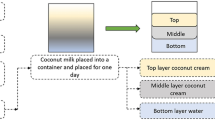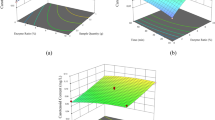Abstract
Several renewable energy initiatives are being established worldwide as the demand for oil rises and the fossil-based resource depletes. In this study, the seeds of bitaog (Calophyllum inophyllum L.), a non-edible feedstock, were utilized as biomass in extracting oil. Oil extraction via ultrasonic-assisted solvent extraction (UASE), set at 35 µm resonance amplitude, was initially conducted using two solvents: n-hexane (n) and petroleum ethers (HPe). The best volumes of each solvent with the highest oil yields were used in the subsequent experiment and as a solvent ratio (n-HPe) variable. The effects of solvent ratio (n-HPe) and the extraction time on oil yield were considered in the design of experiments using Design Expert software’s response surface methodology. The oil extractions via UASE resulted in a yield of 60 ± 1.17% at a 1.38:1 n-HPe ratio and at 40 min extraction time. The oil was dark green with a density of 0.92 g/mL at room temperature, a pH value of 6.21, and a high heating value of 41.90 MJ/kg. The FTIR and GC–MS analyses showed the presence of carboxylic acids and ester carbonyl functional groups. The percentages of fatty acids present in the oil were stearic 14.57, palmitic 13.18, myristic 0.02, lauric 0.17, margaric 0.1, arachidic 0.67, oleic 45.83, palmitoleic 0.2, eicosenoic 0.2, linoleic 24.96, and linolenic 0.1. The unsaturated fatty acid of the extracted oil from C. inophyllum L. seeds was 71.29% of the total fatty acid, indicating that the oil can be converted to biodiesel. The remaining 28.71% is composed of saturated fatty acids. The oil yield via UASE extraction with n-HPe was 60% better compared to 56% and 30% for Soxhlet and traditional solvent extraction by stirring, respectively. The overall result illustrates the efficacy of ultrasonication in boosting oil extraction efficiency.








Similar content being viewed by others
Data availability
All data generated or analyzed during this study can be available upon request. If needed, you may contact the corresponding author for a soft copy of the data.
References
Shamsuddin NM, Yusup S, Ibrahim WA et al (2015) Oil extraction from Calophyllum inophyllum L. via Soxhlet extraction: optimization using response surface methodology (RSM). In: 2015 10th Asian Control Conference: Emerging Control Techniques for a Sustainable World. Institute of Electrical and Electronics Engineers Inc, Kota Kinabalu
EL-Seesy AI, Elshobary ME, He Z (2022) Biofuel versus fossil fuel. In: Handbook of algal biofuels. pp 181–193
Irene J, Anne J, Wise DL et al (1996) Control of air toxin particulate and vapor emissions after coal combustion utilizing calcium magnesium acetate. Resour Conserv Recycl 16:15–69
Arazo R, de Luna MD, Capareda S et al (2021) Superior sewage sludge disposal with minimal greenhouse gas emission via fast pyrolysis in a fluidized bed reactor. IOP Conf Ser Earth Environ Sci 765:012094. https://doi.org/10.1088/1755-1315/765/1/012094
Canencia CD, Ano ABS, Gayas EAD et al (2021) Response surface optimization of the bio-oil yield from Jatropha gossypiifolia L. seeds through ultrasonic-assisted solvent extraction. Biomass Convers Biorefinery 1–14. https://doi.org/10.1007/s13399-021-02101-9
Baroutian S, Aroua MK, Aziz A et al (2013) Blended aviation biofuel from esterified Jatropha curcas and waste vegetable oils. J Taiwan Inst Chem Eng 44:911–916. https://doi.org/10.1016/j.jtice.2013.02.007
El Hajam M, Kandri N, Harrach A et al (2019) Physicochemical characterization of softwood waste “cedar” and hardwood waste “mahogany”: comparative study. Mater Today Proc 13:803–811. https://doi.org/10.1016/j.matpr.2019.04.043
Gumaling R, Agusan JR, Ellacer NVC et al (2018) Increased bio-oil yield from Swietenia macrophylla seeds through microwave pretreatment and ultrasonic-assisted solvent extraction. Sustain Environ Res 28:430–437. https://doi.org/10.1016/j.serj.2018.06.003
Gumaling R, Agusan JR, Ellacer NVC et al (2018) Optimized bio-oil yield from Swietenia macrophylla seeds via ultrasonic cavitation through response surface methodology. Energy, Ecol Environ 3:266–278. https://doi.org/10.1007/s40974-018-0098-7
Joven JM, Gadian J, Perez M et al (2020) Optimized ultrasonic-assisted oil extraction and biodiesel production from the seeds of Maesopsis eminii. Ind Crops Prod 155:112772. https://doi.org/10.1016/j.indcrop.2020.112772
Palconite C, Edrolin A, Lustre SN et al (2018) Optimization and characterization of bio-oil produced from Ricinus communis seeds via ultrasonic-assisted solvent extraction through response surface methodology. Sustain Environ Res 28:444–453. https://doi.org/10.1016/j.serj.2018.07.006
Mabayo VI, Aranas JR, Cagas VJ et al (2018) Optimization of oil yield from Hevea brasiliensis seeds through ultrasonic-assisted solvent extraction via response surface methodology. Sustain Environ Res 28:39–46. https://doi.org/10.1016/j.serj.2017.08.001
Ido AL, de Luna MDG, Capareda SC et al (2018) Application of central composite design in the optimization of lipid yield from Scenedesmus obliquus microalgae by ultrasound-assisted solvent extraction. Energy 157:949–956. https://doi.org/10.1016/j.energy.2018.04.171
Behera S, Singh R, Arora R et al (2015) Scope of algae as third generation biofuels. Bioeng Biotechnol 2:1–13. https://doi.org/10.3389/fbioe.2014.00090
Arumugam A, Ponnusami V (2019) Biodiesel production from Calophyllum inophyllum oil a potential non-edible feedstock: an overview. Renew Energy 131:459–471. https://doi.org/10.1016/j.renene.2018.07.059
Habon A (2009) Extraction and characterization of Calophyllum inophyllum L. seed oil for biodiesel in the Philippines. University of the Philippines
Fuad FM, Don MM (2016) Ultrasonic-assisted extraction of oil from Calophyllum inophyllum seeds: optimization of process parameters. J Teknol 10:199–206. https://doi.org/10.11113/jt.v78.4946
Cerny M, Rigal L, Sablayrolles C et al (2018) Direct Calophyllum oil extraction and resin separation with a binary solvent of n-hexane and methanol mixture. Fuel 221:159–164. https://doi.org/10.1016/j.fuel.2018.02.080
Kartika IA, Tresia O, Bernia O et al (2019) A binary solvent for the simultaneous Calophyllum oil-resin extraction and purification. Agric Eng 65:63–69
Munoz R, Fernandes D, Santos D et al (2012) Biodiesel: production, characterization, mettallic corrosion and analytical methods for contaminants. In: Intechopen. pp 9–10
Marta H, Gunawan S (2018) Separation and identification of fatty acid in triacylglycerol isolated from Calophyllum inophyllum oil. Eng Appl Sci 13:442–449
Jain M, Chandrakant U, Orsat V, Raghavan V (2018) A review on assessment of biodiesel production methodologies from Calophyllum inophyllum seed oil. Ind Crop Prod 114:28–44. https://doi.org/10.1016/j.indcrop.2018.01.051
Quaak P (1999) Energy from biomass. Energy Ser. 3
Soni NK, Varma AK, Mondal P, Srivastava MN (2013) Production of bio-oil from native algae of Solani Aquaduct Roorkee. De Gruyter 3:225–234. https://doi.org/10.1515/green-2013-0012
Azmir J, Zaidul ISM, Rahman MM et al (2014) Optimization of oil yield of Phaleria macrocarpa seed using response surface methodology and its fatty acids constituents. Ind Crops Prod 52:405–412. https://doi.org/10.1016/j.indcrop.2013.11.009
Lebon GS, Tzanakis I, Djambazov G et al (2017) Numerical modelling of ultrasonic waves in a bubbly Newtonian liquid using a high-order acoustic cavitation model. Ultrason - Sonochemistry 37:660–668. https://doi.org/10.1016/j.ultsonch.2017.02.031
Liu X, Ou H, Xiang Z, Gregersen H (2019) Optimization, chemical constituents and bioactivity of essential oil from Iberis amara seeds extracted by ultrasound-assisted hydro-distillation compared to conventional techniques. J Appl Res Med Aromat Plants 13:3–5. https://doi.org/10.1016/j.jarmap.2019.100204
Atabani AE, César AD (2011) Calophyllum inophyllum L. – a prospective non-edible biodiesel feedstock: study of biodiesel production, properties, fatty acid composition, blending and engine performance. Renew Sustain Energy Rev 21:749–753
Elangovan T, Anbarasu A, Jeryrajkumar L (2020) Calophyllum inophyllum biodiesel and analysis of its properties at different blends. Int J ChemTech Res 9:220–229
Ramesh K, Amirthagadeswaran KS, Paul VGP (2012) Biodiesel development process from Calophyllum inophyllum seeds. Government College of Technology. Honne Oil Methyl Ester Bio-Diesel Project, India, pp 2–10
Chukwuneke JL, Ewulonu MC, Chukwujike IC, Okolie PC (2020) Physico-chemical analysis of pyrolyzed bio-oil from Swietenia macrophylla (mahogany) wood. Renew Sustain Energy Rev 5:1–23
Seshan K (2016) Catalytic pyrolysis of lignocellulosic biomass
Sivaramakrishnan KP, R, (2011) Determination of higher heating value of biodiesel. Int J Eng Sci Technol 3:7981–7987
Petit S, Madejova J (2013) Fourier transform infrared spectroscopy, 2nd ed. Elsevier Ltd.
Westworth S, Ashwath N, Cozzolino D (2019) Application of FTIR-ATR spectroscopy to detect salinity response in beauty leaf tree (Calophyllum inophyllum L.). Energy Procedia 160:761–768. https://doi.org/10.1016/j.egypro.2019.02.182
Gopinath P, Puhan S, Nagarajan G (2010) Effect of unsaturated fatty acid esters of biodiesel fuels on combustion, performance and emission characteristics of a DI diesel engine. Int J Energy Environ 1:411–430
Puhan S, Saravanan N, Nagarajan G, Vedaraman N (2010) Effect of biodiesel unsaturated fatty acid on combustion characteristics of a DI compression ignition engine. Biomass Bioenerg 34:1079–1088. https://doi.org/10.1016/j.biombioe.2010.02.017
Wen C, Zhang J, Zhang H et al (2018) Advances in ultrasound assisted extraction of bioactive compounds from cash crops - a review. Ultrason - Sonochemistry 48:538–549. https://doi.org/10.1016/j.ultsonch.2018.07.018
Acknowledgements
The authors would like to express their gratitude to the College of Engineering and Technology faculty of the University of Science and Technology of the Southern Philippines—Claveria (USTP Claveria) for their assistance. The authors would also like to thank the Pilipinas Kao, Incorporated for the laboratory analyses.
Funding
This work is institutionally funded by the University of Science and Technology of Southern Philippines.
Author information
Authors and Affiliations
Contributions
All authors have contributed to the study from conceptualization, laboratory experimentation, data gathering, analysis, and interpretation. All authors read and approved the final manuscript.
Corresponding author
Ethics declarations
Conflict of interest
The authors declare no competing interests.
Additional information
Publisher's note
Springer Nature remains neutral with regard to jurisdictional claims in published maps and institutional affiliations.
Rights and permissions
About this article
Cite this article
Manto, A.A., Ramirez, I.F.T., Arnado, L.M. et al. Oil extraction from Calophyllum inophyllum L. seeds through ultrasonication with n-hexane and petroleum ether as solvents. Biomass Conv. Bioref. 14, 5423–5434 (2024). https://doi.org/10.1007/s13399-022-02669-w
Received:
Revised:
Accepted:
Published:
Issue Date:
DOI: https://doi.org/10.1007/s13399-022-02669-w




